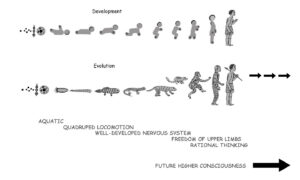Darwin said, “the eye to this day gives me a cold shudder”. If that was true back then, if he had today’s knowledge of the eye he would be shaken down to his genes. A cursory glance at the scientific findings or our visual system reveals an organized complexity at all levels of resolution from millimeter to nanometer.
Take a close look at an eye. Between the object that I fix my gaze on and its sharp image cast onto one of my retinas there stands the cornea, aqueous humour, the iris and pupil, the lens, the vitreous humour
Precorneal tear film provides nutrients, lubrication for the cornea. It is antibacterial and removes debris while allowing light to pass through, refracted but virtually unrestricted. It isn’t a homologous film but consists of three layers, an outer lipid layer, an aqueous layer which supplies oxygen and nutrients to the cornea, and an inner layer of mucus.
Passing through this it then encounters the cornea and is again refracted, and then to the iris which control amount of light, onward through the lens which is adjusted by the ciliary muscles to focus the image at the retina.
From first entering the eye the light passes thorough a series of remarkable structures.
Corneal structure and transparency, by Keith M. Meek and Carlo Knupp, 2015:
The basic principles of corneal structure and transparency have been known for some time, but in recent years X-ray scattering and other methods have revealed that the details of this structure are far more complex than previously thought and that the intricacy of the arrangement of the collagenous lamellae provides the shape and the mechanical properties of the tissue.
If the remarkable structure of the cornea isn’t awe inspiring enough, then surely a glance at the retina will fill anyone with eye-popping astonishment. Not forgetting that retinas are living entities with life cycles that allow the whole to function as the parts are constantly being renewed.
I was inspired by comments in my previous thread to take a closer look at the visual system we share. Just a short time searching for info on this system has provided me with so much detail to add to my basic knowledge of the mechanisms involved. I think we could discuss this in more depth, share knowledge, and have an argument or two along the way. Sounds like fun to me and I’m sure I’ll learn a thing or two.

